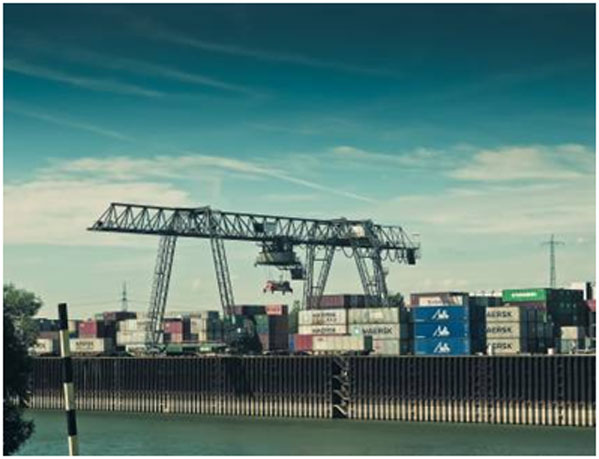
Andrea Weber Riniker serves as executive director of the Port of Tacoma, Washington. As the sixth largest container port in the country and one of the largest in the world, it handles more than thirteen million tons of cargo a year, largely from Asia. Although women remain underrepresented, in maritime transportation the situation is changing rapidly. Andrea believes, "These are great jobs, and I feel very lucky to have one. They're also jobs that I'd like to attract more women to. This is an increasingly global economy, and I want to see women comfortable in positions related to global trade and global economics."
North America's ports, open 365 days a year and 24 hours a day, form a vital component of maritime transportation. Port and harbor facilities provide employment for those engaged in the loading and unloading of commercial ships, in the inspection of cargo, in the underwriting of marine insurance and related capacities.
Stevedores (longshoremen) working in crews load and unload ships and move cargo in and out of warehouses. Much of the stevedore's work was previously simple human labor, but now some operate heavy equipment such as lift trucks and cranes.
The expansion of containerization has modified many of the stevedore's cargo operations. Some companies have cranes that can lift twenty- to forty-foot containers weighing up to forty tons and transport them along a 484-foot frontage area. The speed up and down the track is three hundred feet per minute. Despite this trend toward containerization, however, there are still many opportunities for longshoremen.
Wages vary with the kind of cargo handled; for example, the moving of distress cargo and explosives carries double the hourly rate of general cargo. Cargo thirty-two degrees Fahrenheit or below receive a slightly higher hourly rate than general cargo. Gang bosses supervise stevedores; that is, each stevedore is a member of a gang and operates as such.
Car loaders perform work related to the loading and unloading of railroad cars, trucks, barges, and containers.
Marine carpenters build grain feeders; lash and strap cargo using chain, wire, or rope; repair shipping pallets; and perform all wood-related work. They also crate and pack cargo.
Ship cleaners perform cleaning operations in the ship's hold. Specifically, they wash and paint surfaces, paint by hand and by spray gun, clean oil tanks, take inventory, clean and wash decks, clean and check lifeboats, clean quarters, and sort and check laundry.
Timekeepers govern the timekeeping of work performed on ships, piers, terminals, and barges.
In addition to the mechanics, locker men, gear men, crane operators, truck drivers, guards, watchmen, ship maintenance personnel, and others who work on the docks, several clerical occupations exist. Billing clerk’s type invoices that list the items shipped and the dates of shipment. Manifest clerks compile and type the list of the ship's cargo or passengers for use at custom houses and terminals. Pilot station clerks and dispatchers keep records of the ships entering and leaving harbors. Checkers, generally assigned at the rate of one per gang, note the receiving and delivery of all freight from vessel to pier or marine terminal. Salaries of dock and harbor workers are very good.
Steamship lines offer many opportunities ashore--the employment ranges from executive staff to office clerk similar to most corporations and embraces the following range of activities:
Steamship companies also appoint agents in various cities to represent them and administer their activities. One could pick almost any major city and find opportunities in the steamship business.
One program that is unique exists at Texas A & M University in Galveston--the Bachelor of Science in Maritime Administration. Students take a curriculum composed of accounting, finance, law, and management combined with solid foundations in English, history, and liberal arts courses. In addition, course work in port operations, brokerage and chartering, maritime law, international trade and finance, and others round out this unique and exciting program.
Administrative and professional personnel work to bolster the success and efficiency of the port. They plan campaigns to attract ships to the port through personal contacts and brochures. For example, the South Jersey Port Corporation, an agency of the state of New Jersey, has considerably improved the tonnage of the port of greater Camden.
Each port has an organization (often called the Port Authority) that works for the benefit of shippers, unions, and the improvement of the economy of the port. These authorities also control the activities of the harbor. Several areas have marine trade associations that function as intermediaries in collective bargaining negotiations between shippers and labor unions.
Many harbor workers learn their craft on the job. Applicants for stevedore positions should be in good physical condition; with experience, persons with supervisory ability may become gang bosses. Some harbor workers become machinery operators and receive training from experienced equipment operators. Persons interested in technical or clerical positions should take appropriate course work in high school or community college. Previous work experience in an apprentice role also can be valuable. Many harbor administrators have college backgrounds; others have served as ships' officers or have come up through the ranks.
Employment opportunities will expand in the containerization field and are expected to decline in the traditional areas of cargo handling. However, Jim Traynor of the Philadelphia Marine Trade Association reports, "Pessimists continue to predict that containerization will have a profound effect on the number of available jobs, but all we can say is that it has not really happened in Philadelphia."
See the following articles for more information:
- Find Your Calling: A Checklist
- 5 Ways To Build Your Career Outside of the Office
- How To Impress Your Interviewer When Making a Career Change
- 5 Tips For Successful Networking
